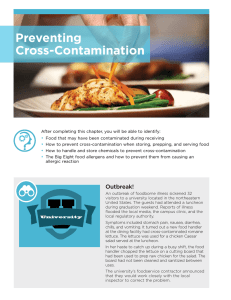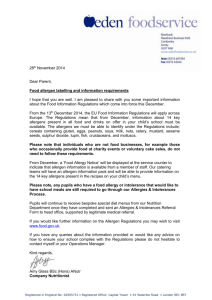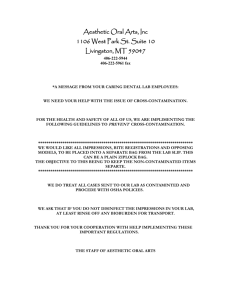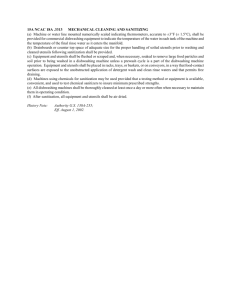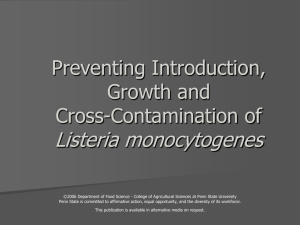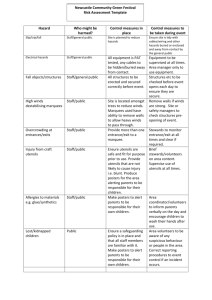Preventing Cross-Contamination
advertisement
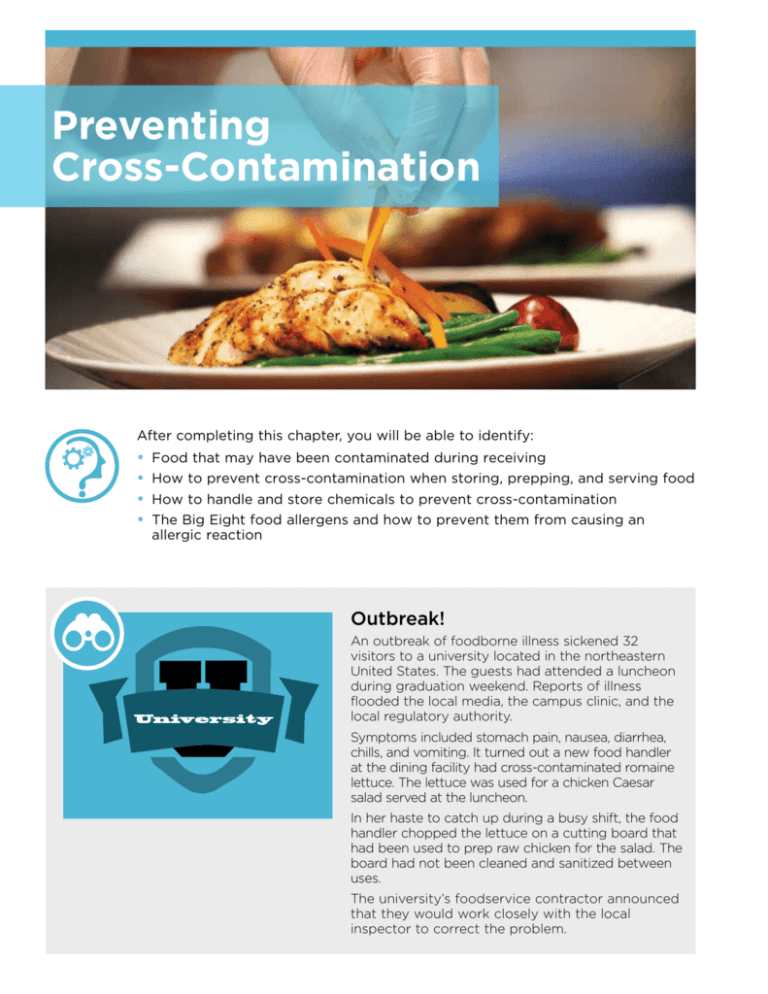
Preventing Cross-Contamination After completing this chapter, you will be able to identify: • Food that may have been contaminated during receiving • How to prevent cross-contamination when storing, prepping, and serving food • How to handle and store chemicals to prevent cross-contamination • The Big Eight food allergens and how to prevent them from causing an allergic reaction Outbreak! An outbreak of foodborne illness sickened 32 visitors to a university located in the northeastern United States. The guests had attended a luncheon during graduation weekend. Reports of illness flooded the local media, the campus clinic, and the local regulatory authority. Symptoms included stomach pain, nausea, diarrhea, chills, and vomiting. It turned out a new food handler at the dining facility had cross-contaminated romaine lettuce. The lettuce was used for a chicken Caesar salad served at the luncheon. In her haste to catch up during a busy shift, the food handler chopped the lettuce on a cutting board that had been used to prep raw chicken for the salad. The board had not been cleaned and sanitized between uses. The university’s foodservice contractor announced that they would work closely with the local inspector to correct the problem. Preventing Cross-Contamination of Food Pathogens can be transferred from one surface or food to another. This is called cross-contamination. Fortunately there are steps you can take to prevent it. The first step is to keep contaminated food out of the operation. The same goes for nonfood items such as single-use cups, utensils, and napkins. Packaging must be intact and clean. Reject items if the packaging is dirty, water stained, leaking, or discolored. Packaging should not have holes, tears, punctures, or other types of damage. Make sure the cans you receive are not dented, rusty, or have swollen ends. Always reject items if you see signs of pests. Your manager may have other guidelines to follow when receiving food. Preventing Cross-Contamination When Storing Food Storage is one place where cross-contamination can happen. It’s not hard to keep food safe in storage if you know what to do. Follow these guidelines. • Store food only in designated food- storage areas. • Store food and nonfood items away from walls and at least six inches (15 centimeters) off the floor. • Wrap or cover food before storing it. This can stop contaminants from falling into food. • NEVER use old chemical containers to store food. This could cause chemical contamination. • Only store food in containers intended for food. • Store raw and ready-to-eat food separately if possible. This should also be done when transporting food for off-site service. • If separate storage is not possible, store food in the following top to bottom order: ready-to-eat food; seafood; whole cuts of beef and pork; ground meat and ground fish; whole and ground poultry. • This order is based on the minimum internal cooking temperature of each food. 4-1 Preventing Cross-Contamination When Prepping Food When you prep food, you may handle both raw and ready-to-eat food items. Pathogens can be transferred from one food to another if you are not careful. That could make you or your guests sick. To stay safe, follow these guidelines. • Make sure workstations, cutting boards, equipment, and utensils are cleaned and sanitized. • Do NOT allow ready-to-eat food to touch surfaces that have come in contact with raw meat, seafood, or poultry. • Prep raw meat, seafood, and poultry at a different time than ready- 7:00 a.m. to-eat food when using the same table. • Clean and sanitize work surfaces, utensils, and equipment between each product. 9:00 a.m. Some foodborne illnesses are caused by contaminated produce. To keep guests safe, produce should be washed. • Clean and sanitize the prep sink and work area before starting. • Wash produce in running water slightly warmer than the food. Be sure to pull apart leafy greens such as lettuce or spinach. • When soaking or storing produce in standing water or ice water, do not mix different items or multiple batches of the same item. • Refrigerate and hold sliced melons, cut tomatoes, and cut leafy greens at 41°F (5°C) or lower. 4-2 Preventing Cross-Contamination in Self-Service Areas Customers can cross-contaminate food when they serve themselves. It can happen when they refill dirty plates or reuse dirty utensils. It can also happen when they pick up food with bare hands, or place their heads underneath the sneeze guard while reaching food. Self-service areas must be protected from contamination. That includes biological, chemical, and physical contaminants. Here’s how to keep them safe. • Make sure food is labeled. • Provide separate utensils for each item. • Keep food under the sneeze guard. This helps protect it from contaminants. • Do NOT let customers refill their dirty plates. • Do NOT let customers use dirty utensils. • If you see customers doing these things, ask them to use clean plates and utensils. • NEVER serve ice that was used to keep food or beverages cold. Bite Size KEEPING FOOD SEPARATE WHEN PREPARING IS ONE WAY TO PREVENT CROSS-CONTAMINATION. SOME KITCHENS USE RED CUTTING BOARDS FOR MEAT AND GREEN CUTTING BOARDS FOR VEGETABLES. BY USING SEPARATE EQUIPMENT, THEY REDUCE THE CHANCE THAT RAW MEAT WILL TOUCH READY-TO-EAT VEGETABLES. 4-3 Preventing Cross-Contamination When Serving Food Surfaces that touch food are called food-contact surfaces. Many of the utensils and equipment you use have food-contact surfaces. Plates, glasses, forks, and tongs are examples. You can contaminate these surfaces if you are not careful when handling them. Follow these practices to prevent this. • Do NOT touch the parts of dishes or glassware that come in contact with food. • Hold dishes by the bottom or edge. • Hold glasses by the middle, bottom, or stem. • Do NOT stack glasses when carrying them. • Carry glasses in a rack or tray. • Do NOT hold utensils by the parts that come in contact with food. • Hold utensils by the handle. • Do NOT use bare hands to handle ready-to-eat food. • Use tongs, deli sheets, or gloves. • NEVER scoop ice with your bare hands or a glass. • Use ice scoops or tongs to get ice. 4-4 • NEVER store towels in your apron or uniform pocket. • Store towels for cleaning food spills in a sanitizer solution when you are not using them. • NEVER use towels for cleaning food spills for any other purpose. • NEVER use the same utensils when handling: °° Ready-to-eat food and raw meat, poultry, or seafood °° Different food items • Use separate utensils when serving different food items. • Store serving utensils in food with the handles extended above the rims of the containers. • Cover food to protect it from contaminants. Apply Your Knowledge Spot the Cross-Contamination Write an next to the actions that could cause cross-contamination. A Storing ready-to-eat food in a separate cooler from raw food E Wrapping a hamburger while wearing single-use gloves B Storing cleaning chemicals and dry pasta in the same area F Serving a drink by holding it from the top of the glass C Placing potato salad underneath raw chicken in a cooler G Scooping ice from the ice bin with bare hands D Using the same spatula for raw hamburgers and cooked hamburgers H Providing a single set of tongs for all items in the self-service area Apply Your Knowledge Prep That Food Safely Write an next to each situation that is unsafe. A Bob debones raw chicken on a white cutting board. He immediately uses the same knife and cutting board to dice onions. B Mary trims a raw roast on a red cutting board. She washes her hands and puts on new gloves. Then she uses a new knife to slice tomatoes on a green cutting board. C Ted preps salads from 8:00 a.m. to 9:00 a.m. He cleans and sanitizes the prep table and the knife and cutting board. Mary filets raw fish on the same prep table at 9:30 a.m. For answers, please turn to the Answer Key. 4-5 Preventing Cross-Contamination in Storage Areas It is important to keep food from direct contamination. It is just as important to protect nonfood items from contamination. A contaminated bowl can cause an illness just as easily as a contaminated salad. That’s why it is so important to store utensils and equipment safely. Cleaning supplies and chemicals must also be handled safely. When stored incorrectly, a bottle of sanitizer might contaminate food or equipment. Storing Utensils and Equipment Utensils and equipment with food-contact surfaces, such as cutting boards, must be stored in ways that prevent contamination. The same is true for nonfood items such as napkins and plastic forks and knives. Follow these guidelines. • Store utensils and equipment that touches food at least six inches (15 centimeters) off the floor. 6"(15 cm) • Store glasses and cups upside down on a clean and sanitized surface. This keeps things from falling in them. • Store utensils with handles up. This keeps people from touching the food-contact surface. Bite Size 4-6 SOME PEOPLE WONDER WHY FOOD AND SUPPLIES MUST BE STORED SIX INCHES (15 CM) OFF THE GROUND. IT’S SIMPLE: THIS KEEPS THESE THINGS AWAY FROM SPLASHES AND SPILLS. AND IT MAKES IT EASY TO CLEAN UNDER AND BEHIND THE SHELVES. Storing Chemicals and Cleaning Supplies Chemicals and cleaning supplies must be stored in the correct place to prevent food contamination. If not, chemicals could contaminate food. Dirty cleaning tools, such as a mop, can also be a hazard to food. • Always store chemicals and cleaning supplies in the designated storage area. • Ask your manager where these items should be stored. • Store chemicals in their original containers. If chemicals are transferred to a new container, the label on the container must list the common name of the chemical. • NEVER store chemicals and cleaning supplies near food. The chemicals might get on the food. • NEVER store cleaning equipment near food. Dirty equipment might contaminate the food. • Dispose of chemicals according to their labels. • Always dump mop water and other dirty liquids into a designated service sink with a floor drain. • NEVER dump mop water or dirty liquids into a toilet or urinal. It might contaminate the cleaning equipment and spread pathogens. Apply Your Knowledge What’s The Problem? Draw an through the situations that can cause cross-contamination. 1 2 4 3 5 For answers, please turn to the Answer Key. 6 4-7 What to Do if Cross-Contamination Happens There are several things you should do if you notice that cross-contamination has happened. If you see a problem, act right away. • Do your best to fix the problem. • Set aside the contaminated item so no one can use it. • Ask your manager what to do. Apply Your Knowledge Now What? 1 Frank got some desserts from the cooler and found raw meat juice on them. Write an next to what he should do. A Wipe off the meat juice and then serve them. B Set the desserts aside and then tell his manager. 4-8 C Throw out the desserts with juice on them and then serve the remaining ones. D Throw them all out and then tell his manager. For answers, please turn to the Answer Key. What to Do for People Who Have Food Allergies Some people are allergic to certain types of food. The tiniest speck of a food they are allergic to can make them sick or even cause death. You must keep this food away from these customers. When a food item containing an allergen comes in contact with another food item and their proteins mix, it is called cross-contact. This can be dangerous for guests with food allergies. Food should be stored and handled in a way that prevents cross-contact. Many of the things you do already, including handwashing and practicing good personal hygiene, will also help prevent cross-contact. The Most Common Food Allergens The proteins that cause allergic reactions are called allergens. Many different food items can cause allergic reactions. But just eight food items cause most reactions. These are called the Big Eight. You need to be aware of the Big Eight and the dishes on your menu that contain them. Here are the Big Eight allergens. • Milk • Eggs • Soy • Fish, such as • Tree nuts, such as • Peanuts • Crustacean • Wheat almonds, walnuts, and pecans shellfish, such as crab, lobster, and shrimp bass, flounder, and cod 4-9 Serving Customers with Food Allergies Both servers and kitchen staff must do their parts to keep customers with food allergies safe. When a customer says that he or she has a food allergy, you need to pay attention. There are special steps to take for an allergen special order. That includes reading food labels and checking for allergens. Servers need to be able to answer questions about food allergies. They should also know how to prevent cross-contact. Here’s how to keep guests safe. • Tell the customer how each dish is made. It is important for you to know which dishes contain Big Eight allergens. If you are not sure, ask your manager. • Tell the customer if any “secret” ingredients contain allergens. Food should always be honestly presented. • Suggest menu items that do not have the food allergen. • Identify the allergen special order. Clearly indicate the order for the guest with a food allergy. Kitchen staff need this information. • Hand deliver the allergen special order to the guest. Do this separately from other food to prevent cross-contact. These practices also apply to other food sensitivities a customer may have, such as a gluten intolerance. 4-10 Prepping Food for Customers with Food Allergies Make sure the allergen is not transferred from food containing the allergen to a customer’s food. Even a small amount of contact can be bad. For example, think about a guest with a shellfish allergy who orders chicken nuggets. If the chicken nuggets are cooked in a fryer that was used for shrimp, that could cause an allergic reaction. Here’s how to prepare an allergen special order. • Check recipes and ingredient labels. Make sure the allergen is not present. • Wash, rinse, and sanitize cookware, utensils, and equipment before prepping the food. This includes food-prep surfaces. Some operations use a separate set of utensils just for allergen special orders. • Make sure the allergen does not touch anything for these customers, including food, beverages, utensils, equipment, and gloves. • Wash your hands and change gloves before prepping their food. • Use equipment assigned for prepping the allergen special order. Use separate fryers and cooking oils when frying food for customers with food allergies. 4-11 What to Do if Cross-Contact Happens Keeping the guests safe is an important job, so keep your eyes open for cross-contact. There are certain steps you should take if food comes in contact with a food allergen. • Do NOT serve the food to the customer. • Set it aside so it cannot be used. • Tell your manager, who will tell you what to do. What to Do if a Customer Has a Severe Allergic Reaction You might see a customer having a severe allergic reaction to food. If you do, there are several actions to take. • Call the emergency number in your area. • Tell your manager. Bite Size 4-12 FIFTEEN MILLION AMERICANS HAVE FOOD ALLERGIES, AND THE NUMBER IS GOING UP. IN FACT, NEARLY ONE IN THIRTEEN KIDS HAVE A FOOD ALLERGY. THAT’S A LOT OF POTENTIAL CUSTOMERS. Apply Your Knowledge Watching for Food Allergens in the Operation 1 Circle the food items that contain a Big Eight allergen. A B C D 2 José is prepping roast beef and gravy for a customer who is allergic to milk. He doesn’t know whether the gravy in the pot is made with milk or water. Write an he should do. next to what A Reheat the gravy to 212˚F (100˚C). C Stop and ask his manager. B Serve the beef with less gravy. D Use the gravy. 3 Melissa is a server. Her customer is allergic to tree nuts. In the kitchen, she notices pecans sprinkled on the salad her customer ordered. Write an next to what she should do. A Pick the pecans off the salad and serve it with the nuts on the side. C Pick the pecans off the salad and serve it. B Serve the salad, and explain that there are nuts on it. D Set the salad aside and tell her manager. 4 Louis is getting ready to cook an order for a guest with a soy allergy. Write an next to what he should do. A Cook the food to a higher temperature than normal. C Apply hand sanitizer to his hands. D Prepare the meal normally. B Get freshly cleaned and sanitized equipment. For answers, please turn to the Answer Key. 4-13
